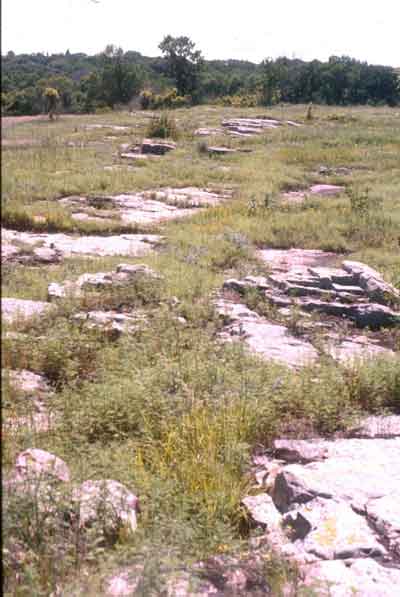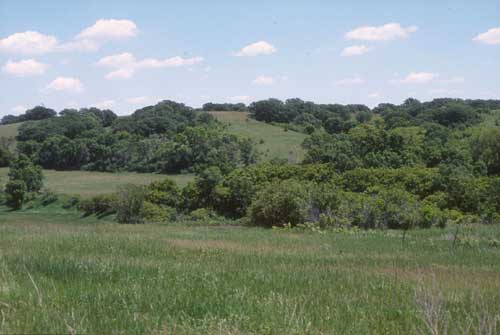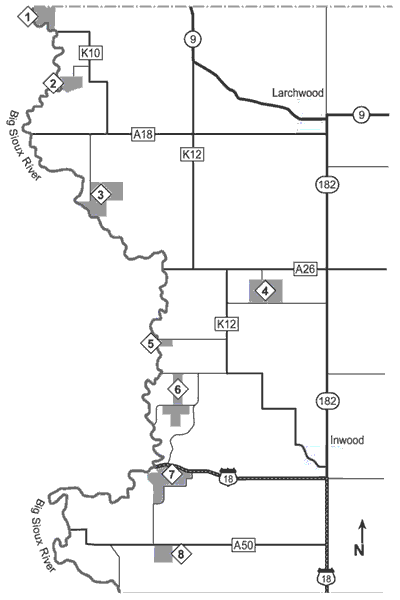 Not many Iowa birders have had the opportunity to explore the state’s far northwestern fringe. Iowa’s border with South Dakota is, however, a good region in which to spend a little discovery time. The Big Sioux River valley in Lyon County offers some picturesque scenery, with scattered prairies, bur oak savannas, and oak-cedar woodlands. These “Little Loess Hills” really are an extension of one of Iowa’s most notable landforms, although a bit more gentle and approachable than the steeper slopes ranging from Sioux City south to Missouri.
Not many Iowa birders have had the opportunity to explore the state’s far northwestern fringe. Iowa’s border with South Dakota is, however, a good region in which to spend a little discovery time. The Big Sioux River valley in Lyon County offers some picturesque scenery, with scattered prairies, bur oak savannas, and oak-cedar woodlands. These “Little Loess Hills” really are an extension of one of Iowa’s most notable landforms, although a bit more gentle and approachable than the steeper slopes ranging from Sioux City south to Missouri.
Sometimes called “the Gateway to the Black Hills” by local residents, the region’s witty moniker has a little more truth to it than might be first apparent. Lying within what geologists refer to as the Northwest Iowa Plains (Prior 1991), the overall landscape often gives visitors a feeling of entering the Dakotas. Additionally, native flora and fauna of western Lyon County tend to become somewhat transitional, with species normally expected further west showing up in these hills along the Big Sioux valley. This article will briefly describe some of the birding opportunities centered on a string of public lands, both natural and historic, flanking the Big Sioux River (Figure 1).
 Any visit to Lyon County should start with a visit to Gitchie Manitou State Preserve (1), one of Iowa’s oldest and most unique preserves (Figure 2). Formerly within the Iowa State Park system and now managed by the Iowa Department of Natural Resources (DNR) Wildlife Bureau, the 121-acre outpost boasts a surprising mix of interesting fauna and flora. The preserve is accessed by a parking lot on its west boundary with Co. Hwy K10 (Apple Avenue). A one-half mile walk down a former entrance road leads to a three-fourths mile looped hiking trail. The trail takes visitors through riparian woodlands and across a wonderful mixed-grass prairie featuring prickly pear cactus and other western flora. Interesting birds to look for include Swainson’s Hawk (nested here for some time in the 1980s), American Woodcock, both cuckoo species, an occasional intergrade (red x yellow) Northern Flicker, Yellow-bellied Sapsucker, Western Kingbird, Blue Grosbeak, Clay-colored Sparrow, Lark Sparrow, and Lark Bunting. Clay-colored Sparrows have been observed during the breeding season (Jackson et al. 1996) and must be considered potential nesters. Yellow-breasted Chats nest in nearby Sioux Falls, SD, and remain a possibility for discovery here. Sharp-tailed Grouse have been reported from nearby private lands a mile southeast of Gitchie Manitou; they were encountered and reported by an experienced, knowledgeable hunter. While visiting Gitchie Manitou, don’t miss viewing the 1.8 billion year-old Sioux Quartzite formations. Among some of the oldest exposed rock in North America, this stone once was quarried here and nearby, and was used for many historic buildings in Sioux Falls, Sioux City, and other smaller communities in the region. The preserve is unique because it has multiple dedications as a geological, archeological, historical, and botanical state preserve (Herzberg and Pearson 2001).
Any visit to Lyon County should start with a visit to Gitchie Manitou State Preserve (1), one of Iowa’s oldest and most unique preserves (Figure 2). Formerly within the Iowa State Park system and now managed by the Iowa Department of Natural Resources (DNR) Wildlife Bureau, the 121-acre outpost boasts a surprising mix of interesting fauna and flora. The preserve is accessed by a parking lot on its west boundary with Co. Hwy K10 (Apple Avenue). A one-half mile walk down a former entrance road leads to a three-fourths mile looped hiking trail. The trail takes visitors through riparian woodlands and across a wonderful mixed-grass prairie featuring prickly pear cactus and other western flora. Interesting birds to look for include Swainson’s Hawk (nested here for some time in the 1980s), American Woodcock, both cuckoo species, an occasional intergrade (red x yellow) Northern Flicker, Yellow-bellied Sapsucker, Western Kingbird, Blue Grosbeak, Clay-colored Sparrow, Lark Sparrow, and Lark Bunting. Clay-colored Sparrows have been observed during the breeding season (Jackson et al. 1996) and must be considered potential nesters. Yellow-breasted Chats nest in nearby Sioux Falls, SD, and remain a possibility for discovery here. Sharp-tailed Grouse have been reported from nearby private lands a mile southeast of Gitchie Manitou; they were encountered and reported by an experienced, knowledgeable hunter. While visiting Gitchie Manitou, don’t miss viewing the 1.8 billion year-old Sioux Quartzite formations. Among some of the oldest exposed rock in North America, this stone once was quarried here and nearby, and was used for many historic buildings in Sioux Falls, Sioux City, and other smaller communities in the region. The preserve is unique because it has multiple dedications as a geological, archeological, historical, and botanical state preserve (Herzberg and Pearson 2001).
Two miles south of Gitchie Manitou is the Blood Run Historic Site (2), another worthwhile stop both for birds and ancient history (Figure 3). Owned by the State Historical Society of Iowa and managed by the Lyon County Conservation Board, the site is listed on the National Register of Historic Places. In fact, Blood Run history is so interesting it might even distract visiting birders. Home to the Oneota, Ioway, and Omaha people from about a.d. 900 to 1720, as many as 3,000 people may have inhabited this small area of river valley at the cultural peak. Although many burial mounds were long ago destroyed by farming, more than 80 remain, making Blood Run one of Iowa’s most important but least known archeological treasures. Access to Blood Run is a gravel road west from Apple Avenue (K10) (look for a directional sign).
From the parking area and visitor kiosk, trails lead through the mounds area, across remnant mixed-grass prairie, and down through overgrown savanna to the river’s floodplain, crossing Blood Run Creek (waterproof footwear needed). Birds to look for here include many of the same varieties listed previously for Gitchie Manitou. In scattered riparian woods along the edge of the Big Sioux River, Green Herons and Orchard Orioles are common nesters, along with extra-limital Blue-gray Gnatcatchers. A Mountain Bluebird, reported to the author by local birders, was never verified but remains a good possibility for this western Iowa outpost, and the species has been recorded a few miles to the south. A Loggerhead Shrike nest in a plum thicket along the area’s entrance road was active for many years, and Blood Run’s brushy habitat component likely still offers good locations for shrikes. The dry prairies on west-facing slopes or hilltops provide good habitat for Western Meadowlark and Lark Sparrow. It appears that Blood Run might provide a probable location for rare Lark Bunting, a species more common just an hour west into South Dakota, as well as Burrowing Owls, which have nested periodically at the nearby town of Larchwood. Documented observations of either species by visiting birders are welcomed by Iowa DNR, Lyon County Conservation Board, and the Iowa Ornithologists Union. This historic site normally is open only during daylight hours and visitors should check the regulations sign for any changes.
 Continuing downstream, the next large tract of public land encountered is Hidden Bridge-Peterson Prairie Wildlife Area (3), owned by the Lyon County Conservation Board. Access is from Apple Avenue (K10), 1.5 miles south of its intersection with Co. Hwy A18. Apple Avenue dead-ends on the wildlife area, and a parking area is provided. An abandoned road may be followed down to the river terrace, but there is no formal trail system, so birders are left to range these big prairie hills at will. A Black-billed Magpie once was observed from a high prairie ridge, and what appeared to be possible abandoned magpie nests later were reported in a couple of cottonwood trees (Harr 1986). Given periodic reports of magpies in the Sioux City vicinity, this species could be found here at any time. Other species of interest here include nesting Loggerhead Shrikes, one of which the author, Harold White, and Lee and Nancy Schoenewe once observed carrying a male Eastern Bluebird. A Mountain Bluebird was recorded here in 1996 (Kent 1996), and this remains good habitat for the possibility of future observations. The wonderful prairies and scattered brush at Hidden Bridge appeal to Upland Sandpipers, Bobolinks, Field Sparrows, and Blue Grosbeaks, among others. Fall raptor migration viewing also can be excellent along the area’s wind-swept ridges, and Northern Harriers nested on Peterson Prairie in 2003 (Dinsmore 2003).
Continuing downstream, the next large tract of public land encountered is Hidden Bridge-Peterson Prairie Wildlife Area (3), owned by the Lyon County Conservation Board. Access is from Apple Avenue (K10), 1.5 miles south of its intersection with Co. Hwy A18. Apple Avenue dead-ends on the wildlife area, and a parking area is provided. An abandoned road may be followed down to the river terrace, but there is no formal trail system, so birders are left to range these big prairie hills at will. A Black-billed Magpie once was observed from a high prairie ridge, and what appeared to be possible abandoned magpie nests later were reported in a couple of cottonwood trees (Harr 1986). Given periodic reports of magpies in the Sioux City vicinity, this species could be found here at any time. Other species of interest here include nesting Loggerhead Shrikes, one of which the author, Harold White, and Lee and Nancy Schoenewe once observed carrying a male Eastern Bluebird. A Mountain Bluebird was recorded here in 1996 (Kent 1996), and this remains good habitat for the possibility of future observations. The wonderful prairies and scattered brush at Hidden Bridge appeal to Upland Sandpipers, Bobolinks, Field Sparrows, and Blue Grosbeaks, among others. Fall raptor migration viewing also can be excellent along the area’s wind-swept ridges, and Northern Harriers nested on Peterson Prairie in 2003 (Dinsmore 2003).
To continue downstream, visitors must backtrack to Co. Hwy A18, then three miles east to K12 (Beech Avenue) and continue south on this paved road. If an extended visit is planned to the area (probable, given Lyon County’s distance from almost anywhere), a good place to camp is Lake Pahoja County Park (4), just east of K12 on A26. Entrance and camping fees are charged. The 282-acre park, with an artificial lake, has excellent camping facilities and some camping cabins. Cabins are almost continuously filled in summer, however, so reservations often are needed months in advance. The park itself can offer suitable birding all year round, and it’s a good place to see a wide variety of migrating waterfowl each fall and spring. Both Northern Harriers and Short-eared Owls have been observed on park grasslands south of the lake, although no nests have been located. An interesting side note — the name “Pahoja” (pronounced pa-HO-ya) is an Oneota word translated as “dirty snow.”
Continuing two miles south on K12 from the intersection of K12 and A26, turn west onto 200th Street. After traveling 1.25 miles, the road turns into an unmaintained dirt road that descends a steep hill to a parking lot on an 80-acre parcel of DNR’s Big Sioux River Wildlife Area. Do not attempt driving this road if it has rained within the previous three days or any time if ruts appear particularly deep! Leave vehicles at the top of the hill and to the side of the road. Anyone stuck downhill will find the nearest landowner very unfriendly about offering assistance! Known as the Olson Tract (5), this state land is mostly dense woodland on steep hills. It is situated in the midst of the largest contiguous forest on Iowa’s side of the middle Big Sioux River. Birdlife consists of mostly woodland varieties typically found across the rest of Iowa. The site is rich in nesting Wild Turkey, Eastern Wood-Pewee, White-breasted Nuthatch, Wood Thrush, a number of vireos, Ovenbird, Rose-breasted Grosbeak, and Eastern Towhee. Spotted Towhees occasionally may be found in migration. While Spotted Towhees are not known to nest here, discovery of the species, or Spotted x Eastern hybrids, remains distinctly possible (Silcock 2001). Although not hosting many unusual species, this site offers someone trying to enlarge their Lyon County list a considerable opportunity to add several deep woods species.
It’s again necessary to backtrack to Hwy K12. Continue south one mile, then west three-fourths mile on 210th Street, south one mile on Beech Ave. (K12, then west again one-half mile on 220th. Lands on both sides of the road are part of the Big Sioux River Wildlife Area, Nelson-Lee Tract (6). This is an area of mixed oak-cedar woodlands, oak savanna, remnant prairies and agricultural fields, a deeply cutting stream, and a 3-acre impoundment, thus providing a variety of habitats for birds. No trail system exists, so birders again are on their own to explore the 337 acres of public land. Turkeys abound, and this area formerly was home to a number of Northern Bobwhite, at the northwestern limits of their Iowa range before the national population decline of recent years. Other unusual species (assumed nesting) for northwestern Iowa are American Woodcock and Whip-poor-will. The author has found that, from some of open hilltop ridges, the Nelson tract is a wonderful place to view raptors in fall migration each September and October. Some of the raptors observed personally here include Bald and Golden Eagles, Cooper’s Hawk, Northern Goshawk, Broad-winged Hawk, Swainson’s Hawk, Ferruginous Hawk, and Prairie Falcon, along with more common species. Eastern Bluebirds are very abundant around this public area, nesting in hollow trees along creek bottoms and in the many houses placed on posts along roadsides in the vicinity. Blue Grosbeaks and Western Kingbirds may be commonly observed perched on roadside utility lines (Figure 4). The portion of land north of 220th Street (Lee Tract) was recently purchased through DNR’s new State Wildlife Grants program and has not been fully explored for its birding opportunities. That makes it a ripe area for an energetic birder to explore and perhaps secure some new Lyon County records.
For the next stop, reverse direction and return to Beech Avenue, continuing south as it zigzags its way to U.S. Hwy 18. Immediately south of U.S. 18 at this point is situated the Kroger Tract (7), at 454 acres the largest component of the Big Sioux Wildlife Area and the largest parcel of public timber on Iowa’s side of the Big Sioux. Parking is available near the boat ramp access, just west along Hwy 18. One also can travel one-half mile east, turn south on Able Blvd., and follow a winding road uphill to a couple of parking areas located at the edge of hilltop fields and oak woodland. The first signed parking lot encountered is a good place to access much of the area. An old access road, now closed to vehicles, serves as a good walking trail. It descends through oak woodlands, ending up in abandoned weedy field on the river’s floodplain terrace. Many birds found on this area are the same species as those listed previously for the Olson Tract.
Final stop on our western Lyon County tour is the Lyon County Conservation Board-owned Blankespoor Wildlife Area (8). From the previously-described Kroger Tract, travel 1.25 miles south on Ashley Ave. to the intersection with Co. Hwy A50. Blankespoor Wildlife Area and the public parking lot are located immediately south of this “T” intersection. Habitat is a now-familiar mix of oak savanna, oak-cedar woodlands, small prairie remnants, and farm fields, with a couple of small impoundments. Acquired in the mid-1990s, this area has yet to be fully explored by birders and offers another great opportunity for some unexpected finds.
Public lands along the Big Sioux River, and farther downstream in Sioux County, form a “string of pearls” along this scenic valley. It has long been a dream of the Department of Natural Resources, local county conservation boards, and South Dakota’s Department of Game Fish and Parks, to create a major green belt between Sioux City and Sioux Falls. With respective populations of approximately 85,000 and 125,000 residents, and another 40,000 or so between the larger metropolitan centers, the river has become a major target for both outdoor recreation and rural housing developments. Should the latter predominate, this interesting ecological transition area between eastern and western United States could suffer. Some dedicated birding and new records of unusual Iowa species might help in the struggle to keep the Big Sioux River corridor in a relatively natural condition.

Western Lyon County birding areas
(1) Gitchie Manitou State Preserve
(2) Blood Run Historic Site
(3) Hidden Bridge-Peterson Prairie Wildlife Area
(4) Lake Pahoja County Park; Big Sioux River Wildlife Area
(5) Olson Tract
(6) Nelson-Lee Tract
(7) Kroger Tract
(8) Blankespoor Wildlife Area
LITERATURE CITED
Dinsmore, J. J. 2003. Field reports — summer 2003. Iowa Bird Life 73:131.
Harr, D. C. 1986. Black-billed Magpie in Lyon County. Iowa Bird Life 56:32.
Herzberg, R. and J. Pearson. 2001. The Guide to Iowa’s State Preserves. University of Iowa Press, Iowa City.
Jackson, L. S., C. A. Thomson, and J. J. Dinsmore. 1996. The Iowa Breeding Bird Atlas. University of Iowa Press, Iowa City.
Kent, T. H. 1996. Field reports — spring 1996. Iowa Bird Life 66:105.
Prior, J. C. 1991. Landforms of Iowa. University of Iowa Press, Iowa City.
Silcock, R. 2001. In summer, how close are Spotted Towhees to Iowa and to Eastern Towhees? Iowa Bird Life 71:61.